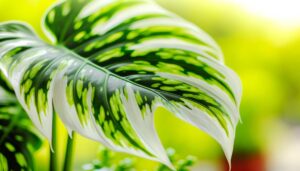Philodendron Swiss Cheese Vs Monstera Adansonii
When comparing Philodendron Swiss Cheese and Monstera Adansonii, you'll notice significant differences in their leaf structures and growth habits. Philodendron Swiss Cheese has deeply lobed leaves with irregular fenestrations, optimizing for light penetration.
In contrast, Monstera Adansonii features elongated, heart-shaped leaves with uniform perforations, aiding in climbing. Both are hemi-epiphytes but differ in internode length and foliage density.
They thrive in bright, indirect light and need well-draining soil. Their unique fenestrations not only enhance their aesthetic appeal but also improve air circulation and light absorption.
There's more to discover about their distinctive qualities and care needs.
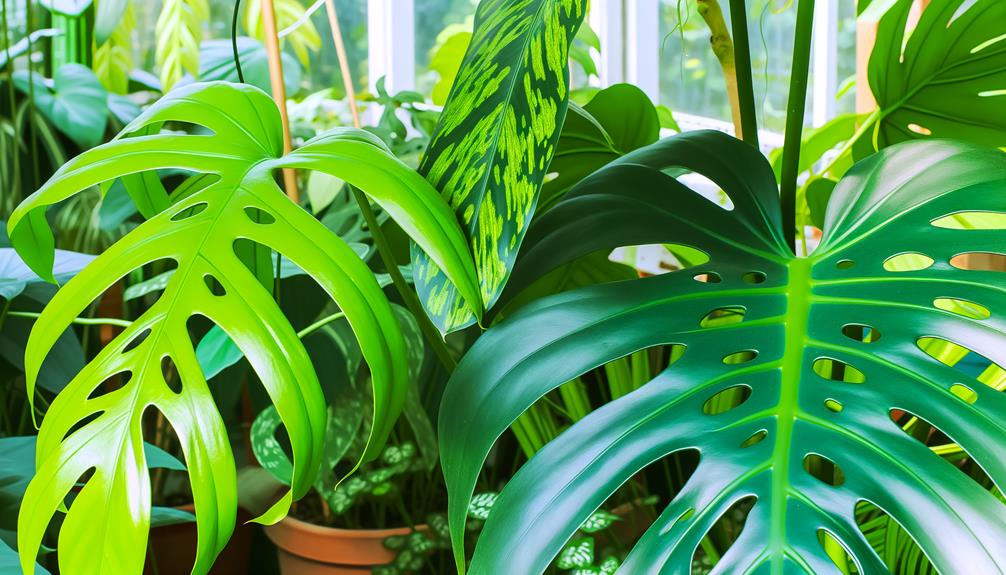
Key Takeaways
- Philodendron Swiss Cheese has deeply lobed leaves with irregular holes, while Monstera Adansonii has heart-shaped leaves with uniform perforations.
- Monstera Adansonii produces fenestrated leaves earlier in its lifecycle compared to Philodendron Swiss Cheese.
- Philodendron Swiss Cheese optimizes for light penetration, whereas Monstera Adansonii focuses on climbing efficiency.
- Both plants thrive in bright, indirect light and require consistent moisture without waterlogging.
- Common pests include spider mites, aphids, and mealybugs; neem oil and insecticidal soap are effective treatments.
Origins and Classification

In the field of botanical taxonomy, Philodendron Swiss Cheese and Monstera Adansonii are often confused, but they belong to distinct genera within the Araceae family.
You'll find that Philodendron Swiss Cheese is classified under the genus Philodendron, known for its diverse species and adaptive growth habits. Monstera Adansonii, conversely, belongs to the genus Monstera, which is renowned for its unique fenestrations and larger leaf structures.
Both plants originate from tropical regions of Central and South America, thriving in humid, shaded environments. While they share some environmental preferences, their genetic distinctions are significant.
DNA sequencing and phylogenetic studies have confirmed their separate evolutionary pathways, underscoring the importance of accurate classification in understanding plant biodiversity.
Leaf Structure
Understanding their distinct evolutionary pathways, it's evident that Philodendron Swiss Cheese and Monstera Adansonii exhibit unique leaf structures that set them apart within the Araceae family.
Philodendron Swiss Cheese features deeply lobed leaves with irregular, fenestrated holes, an adaptation for maximizing light capture in dense forest understories.
Monstera Adansonii, however, displays elongated, heart-shaped leaves with uniform perforations, enhancing its climbing abilities by reducing wind resistance.
Key differences include:
- Fenestration Patterns: Philodendron Swiss Cheese has irregular holes, while Monstera Adansonii shows consistent perforations.
- Leaf Shape: Philodendron Swiss Cheese boasts more lobed, complex leaves; Monstera Adansonii's leaves are more uniformly heart-shaped.
- Adaptation Goals: Philodendron Swiss Cheese optimizes for light penetration, whereas Monstera Adansonii focuses on structural climbing efficiency.
These distinctions are rooted in their unique adaptive strategies.
Growth Habits
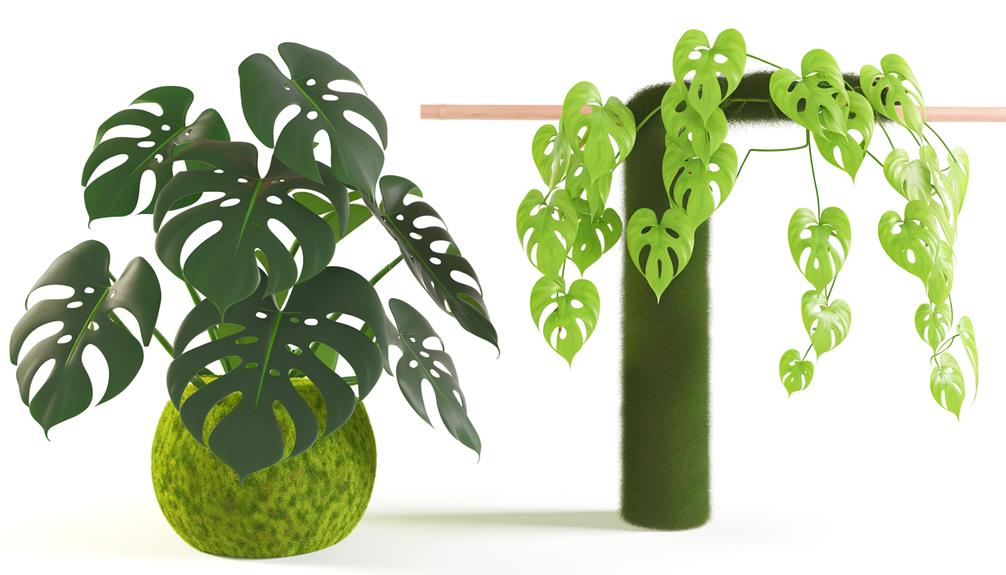
Philodendron Swiss Cheese and Monstera Adansonii exhibit distinct growth habits that reflect their unique ecological niches and evolutionary adaptations.
Philodendron Swiss Cheese, a hemi-epiphyte, often begins life on the forest floor, climbing trees for light. Its growth is characterized by elongated internodes and aerial roots that anchor it to surfaces.
In contrast, Monstera Adansonii, also a hemi-epiphyte, displays a more compact growth with shorter internodes. It produces fenestrated leaves earlier in its lifecycle, an adaptation for maximizing light capture in dense forests.
Both plants utilize climbing strategies, but Monstera Adansonii's growth is more structured, with a propensity for forming dense foliage.
Understanding these growth habits helps you appreciate their evolutionary strategies and predict how they'll behave in your living space.
Care Requirements
When caring for Philodendron Swiss Cheese and Monstera Adansonii, you'll need to think about their specific light and temperature needs, watering and humidity preferences, and soil and fertilizer requirements.
Both species thrive in bright, indirect light but have different tolerances to temperature variations.
Ensuring best watering schedules and humidity levels, alongside appropriate soil and nutrient supplies, will help these plants flourish.
Light and Temperature Needs
Both Philodendron Swiss Cheese and Monstera Adansonii thrive in bright, indirect light and require temperatures between 65-80°F for ideal growth. Ensuring best light conditions is essential for photosynthesis and robust development.
Direct sunlight can cause leaf burn, so place them near east or west-facing windows with filtered light.
Key light and temperature considerations include:
- Avoid direct sunlight: Prolonged exposure can damage foliage.
- Maintain stable temperatures: Fluctuations outside the 65-80°F range can stress the plants.
- Monitor light intensity: Use sheer curtains or shades to diffuse intense sunlight.
Consistent environmental conditions support healthy growth and prevent issues like leaf yellowing or stunted development. Adhering to these guidelines will help your plants flourish.
Watering and Humidity Preferences
Proper watering and maintaining high humidity levels are essential for the best growth of Swiss Cheese Plants and Monstera Adansonii. You should keep the soil consistently moist but not waterlogged. Overwatering can lead to root rot, while underwatering will cause wilting. Aim for a humidity level of 60-80%, which mimics their native tropical environment. Both plants benefit from regular misting and the use of a humidifier.
| Aspect | Requirements |
|---|---|
| Watering | Consistently moist, not waterlogged |
| Humidity Level | 60-80% |
| Additional Care | Regular misting, use of humidifier |
Soil and Fertilizer Requirements
Understanding the soil and fertilizer requirements is key to ensuring the best health and growth for Philodendron Swiss Cheese and Monstera Adansonii. Both plants thrive in well-draining, nutrient-rich soil. Use a mix that includes peat moss, perlite, and orchid bark to replicate their natural habitat.
Regular fertilization during the growing season optimizes growth. Apply a balanced, water-soluble fertilizer every 4-6 weeks.
- Soil Composition: Use a mix of peat moss, perlite, and orchid bark.
- Fertilizer Type: Select a balanced, water-soluble fertilizer.
- Application Frequency: Fertilize every 4-6 weeks during active growth.
Avoid over-fertilizing, as it can lead to nutrient burn. Monitor soil moisture to prevent root rot, ensuring your plants stay healthy and vibrant.
Propagation Methods
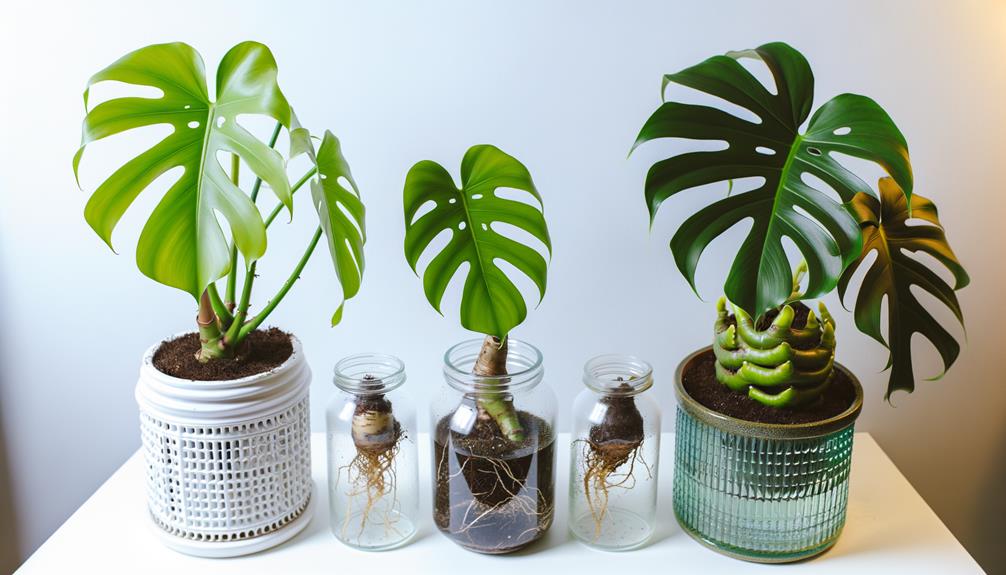
When propagating Philodendron Swiss Cheese and Monstera Adansonii, you should start by selecting healthy stem cuttings with at least one node. Cut just below the node using sterilized pruning shears to prevent infection.
Place the cuttings in a jar of water, ensuring the node is submerged. Change the water every few days to maintain oxygen levels, which promotes root development.
After roots reach 2-3 inches, transfer the cuttings into a well-draining soil mix. Alternatively, you can plant the cuttings directly into soil. Keep the soil moist but not waterlogged.
Use a humidity dome to create a humid microclimate, enhancing root growth. Both methods are effective, but water propagation lets you monitor root development more easily.
Common Issues
You'll often encounter yellowing leaves and pest infestations with both Philodendron Swiss Cheese and Monstera Adansonii. Yellowing typically results from overwatering or nutrient deficiencies, while pests like spider mites and aphids can cause significant damage.
Effective management includes adjusting watering practices and implementing integrated pest control measures.
Yellowing Leaves
Yellowing leaves in both Philodendron Swiss Cheese and Monstera Adansonii often indicate issues related to improper watering, nutrient deficiencies, or inadequate light conditions. Make sure you're not overwatering, as soggy soil can lead to root rot, which manifests as yellowing leaves.
Conversely, underwatering can also cause yellowing due to dehydration stress.
To address yellowing leaves, consider:
- Watering habits: Allow the top inch of soil to dry out before watering.
- Nutrient supplementation: Apply a balanced, water-soluble fertilizer every 4-6 weeks during the growing season.
- Light conditions: Place your plant in bright, indirect light to avoid leaf chlorosis.
Pest Infestations
While addressing yellowing leaves, you might also need to be watchful about common pest infestations that can afflict both Philodendron Swiss Cheese and Monstera Adansonii. Spider mites, aphids, and mealybugs are frequent culprits.
Spider mites cause stippling and fine webbing on leaves, often leading to chlorosis. Aphids, small and pear-shaped, can cluster on new growth, excreting honeydew that fosters sooty mold. Mealybugs appear as cottony masses, weakening plants by sucking sap.
To manage these pests, employ neem oil or insecticidal soap, ensuring thorough coverage. Regularly inspect your plants, focusing on leaf undersides and new growth. Isolate infested plants to prevent spread. Consistent monitoring and prompt intervention are essential to maintain plant health and growth.
Indoor Decor Potential
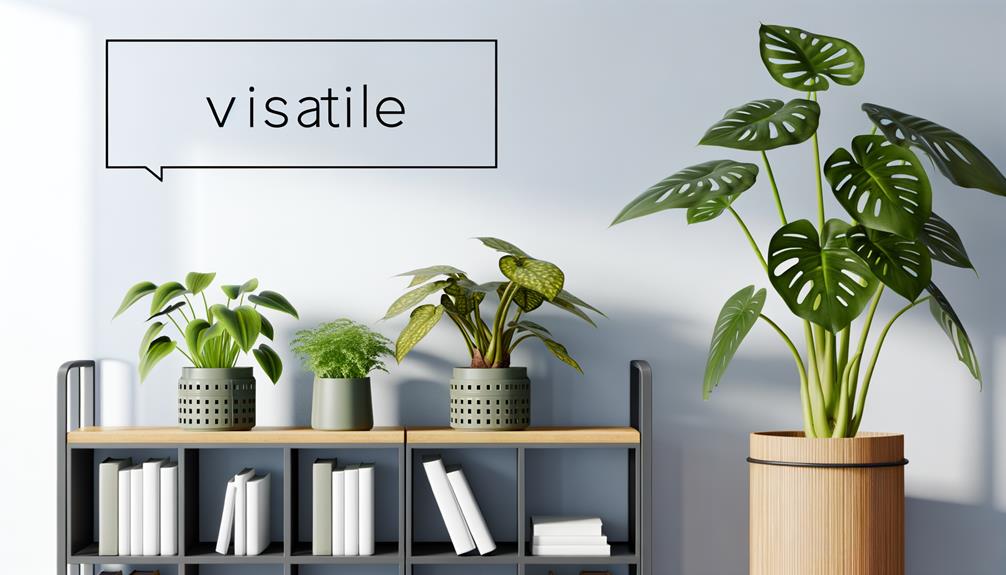
Philodendron Swiss Cheese and Monstera Adansonii both exhibit unique fenestrations that make them exceptional choices for enhancing indoor decor. These fenestrations, or natural leaf perforations, increase light penetration and air flow, creating a visually dynamic atmosphere.
You'll find these plants offer several decor benefits:
- Versatile Placement: Suitable for various indoor environments, from living rooms to offices.
- Air Purification: Both species effectively remove airborne toxins, improving air quality.
- Low Light Adaptation: They thrive in low to medium light, making them ideal for spaces with limited sunlight.
Each plant's distinct morphology provides a scientifically-backed method to elevate indoor aesthetics while promoting a healthier environment. By integrating either species, you're not only beautifying your space but also enhancing its functionality.
Conclusion
In comparing Philodendron Swiss Cheese and Monstera adansonii, it's fascinating that Monstera adansonii can grow up to 13 feet in ideal conditions, making it a striking choice for indoor decor.
Both plants have unique leaf structures and specific care requirements, but they share a love for humidity and indirect light.
Understanding their differences and similarities will help you make an informed decision, ensuring a thriving and aesthetically pleasing addition to your indoor garden.


